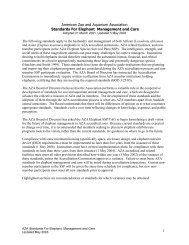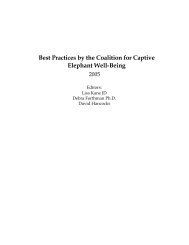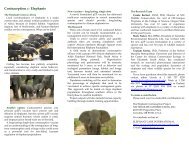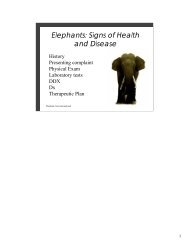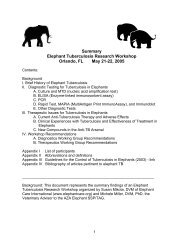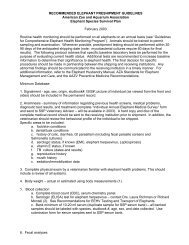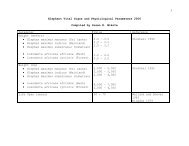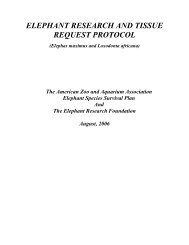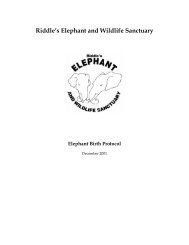Nepal Elephant TB Control and Mgt Action Plan.pdf - Elephant Care ...
Nepal Elephant TB Control and Mgt Action Plan.pdf - Elephant Care ...
Nepal Elephant TB Control and Mgt Action Plan.pdf - Elephant Care ...
- No tags were found...
You also want an ePaper? Increase the reach of your titles
YUMPU automatically turns print PDFs into web optimized ePapers that Google loves.
<strong>Nepal</strong> <strong>Elephant</strong> Tuberculosis ulosis<strong>Control</strong> <strong>and</strong>Management agemen<strong>Action</strong> <strong>Plan</strong> (2011-2015)2015)that have had no known exposure to an infectedelephant or human may elect Opon 2. Opon2 may also be suitable for old elephants or asa temporary opon for pregnant elephants.<strong>Elephant</strong>s in this sub-group should not work<strong>and</strong> must remain segregated from serologicallynon-reacve elephants <strong>and</strong> from wild elephants<strong>and</strong> other wild ungulates unl they have had twonon-reacve DPP tests.Group 2 <strong>TB</strong>-suspect elephant may or may not beshedding <strong>TB</strong> organisms. Staff caring for elephantsin this group should consider personal protecon(see secon 1.6).The combinaon of a reacve <strong>Elephant</strong> <strong>TB</strong> Stat-Pak ® test <strong>and</strong> a non-reacve DPP ® Vet<strong>TB</strong> testmay be due to the one of the following:1. Early sero-conversion. The elephant is trulyinfected but seroconversion on the <strong>Elephant</strong><strong>TB</strong> Stat-Pak ® has preceded seroconversion onthe DPP. <strong>TB</strong> is a chronic disease <strong>and</strong> the body’sanbody response may vary with the stage ofthe disease which can affect test results. Furtherresearch to be er underst<strong>and</strong> the elephantimmune system is on-going (L<strong>and</strong>olfi et al. 2009,L<strong>and</strong>olfi et al. 2010). In almost all cases to dateculture posive (shedding) elephants have beenreacve on both the <strong>Elephant</strong> <strong>TB</strong> Stat-Pak ® <strong>and</strong>the DPP ® Vet<strong>TB</strong> tests. While elephants thatare <strong>Elephant</strong> <strong>TB</strong> Stat-Pak ® reacve <strong>and</strong> DPP ®Vet<strong>TB</strong> non-reacve are probably less likely tobe shedding they may convert to DPP ® Vet<strong>TB</strong>reacve status <strong>and</strong> / or become <strong>TB</strong> cultureposive<strong>and</strong> shed <strong>TB</strong> organisms at any me. Thishas occurred in a several cases including a case in<strong>Nepal</strong>.2. Prior treatment for <strong>TB</strong>.3. In rare instances, the <strong>Elephant</strong> <strong>TB</strong> Stat-Pak ®may produce false posive results. The <strong>Elephant</strong><strong>TB</strong> Stat-Pak ® may cross-react with certain NTMsuch as M. szulgai, which caused the death oftwo African elephants (Lacasse et al. 2007).It has been demonstrated however, that the<strong>Elephant</strong> <strong>TB</strong> Stat-Pak ® <strong>and</strong> DPP ® Vet<strong>TB</strong> tests donot react with 11 other NTMs nor with M. avium(Greenwald et al. 2009). In one study, only 4 of147 cases in the U.S. <strong>and</strong> Europe were consideredto be false-posives (Greenwald et al. 2009).Group 3. <strong>TB</strong>-infected. An elephant that is reacveon the <strong>Elephant</strong> <strong>TB</strong> Stat-Pak ® <strong>and</strong> the DPP ®Vet<strong>TB</strong> tests <strong>and</strong> /or from which M. tuberculosiscomplex organisms have been idenfied byculture or molecular techniques.• Segregate according to procedures in Secon1.4.• Collect respiratory samples for culture <strong>and</strong>molecular diagnoscs (see procedure below)before iniang treatment.• If culture is posive perform drug sensivitytesng.• Iniate treatment as soon as possible <strong>and</strong>suspend work <strong>and</strong> public contact unl theelephant has completed 90 consecuve daysof treatment (90 full doses). Treat accordingto protocols in secon 1.5• <strong>Elephant</strong>s that have a posive culture areknown to be shedding, are a higher risk totransmit <strong>TB</strong> <strong>and</strong> should be segregated for theduraon of treatment.• Instute precauons to protect human health.• Document that treatment is carried out inaccordance with these guidelines. The <strong>TB</strong><strong>Plan</strong> Veterinary Officer will be responsible formonitoring treatment.• Monitor post-treatment with culture <strong>and</strong>molecular techniques as the <strong>Elephant</strong> <strong>TB</strong> Stat-Pak ® test will remain reacve for some me.6




